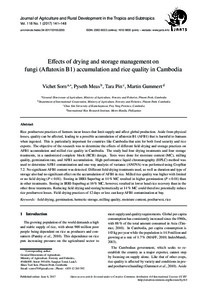| dc.date.accessioned | 2017-06-08T07:21:07Z | |
| dc.date.available | 2017-06-08T07:21:07Z | |
| dc.date.issued | 2017-06-06 | |
| dc.identifier.issn | 1612-9830 | |
| dc.identifier.issn | 2363-6033 | |
| dc.identifier.uri | urn:nbn:de:hebis:34-2017031552255 | |
| dc.identifier.uri | http://hdl.handle.net/123456789/2017031552255 | |
| dc.language.iso | eng | |
| dc.publisher | Kassel University Press | ger |
| dc.rights | Urheberrechtlich geschützt | |
| dc.rights.uri | https://rightsstatements.org/page/InC/1.0/ | |
| dc.subject | field drying | eng |
| dc.subject | germination | eng |
| dc.subject | hermetic storage | eng |
| dc.subject | milling quality | eng |
| dc.subject | moisture content | eng |
| dc.subject | postharvest | eng |
| dc.subject | rice | eng |
| dc.subject.ddc | 630 | |
| dc.title | Effects of drying and storage management on fungi (Aflatoxin B1) accumulation and rice quality in Cambodia | eng |
| dc.type | Aufsatz | |
| dcterms.abstract | Rice postharvest practices of farmers incur losses that limit supply and affect global production. Aside from physical losses, quality can be affected, leading to a possible accumulation of aflatoxin B1 (AFB1) that is harmful to humans when ingested. This is particularly important for countries like Cambodia that aim for both food security and rice exports. The objective of the research was to determine the effects of different field drying and storage practices on AFB1 accumulation and milled rice quality in Cambodia. The study had four drying treatments and four storage treatments, in a randomized complete block (RCB) design. Tests were done for moisture content (MC), milling quality, germination rate, and AFB1 accumulation. High-performance liquid chromatography (HPLC) method was used to determine AFB1 contamination and one-way analysis of variance (ANOVA) was performed using CropStat 7.2. No significant AFB1 content was detected. Different field drying treatments used, as well as duration and type of storage also had no significant effect on the accumulation of AFB1 in rice. Milled rice quality was higher with limited or no field drying (P<0.01). Storing in IRRI-Superbag at 14% MC resulted in higher germination (P<0.01) than in other treatments. Storing in IRRI-Superbag at 16% MC, however, resulted in lower head rice recovery than in the other three treatments. Reducing field drying and storing hermetically at 14% MC could therefore potentially reduce rice postharvest losses. Field drying practices of 12 days or less can keep AFB1 contamination at bay. | eng |
| dcterms.accessRights | open access | |
| dcterms.bibliographicCitation | In: Journal of Agriculture and Rural Development in the Tropics and Subtropics. Kassel : Kassel University Press. - Vol. 118, No. 1 (2017) S. 141-148 | |
| dcterms.creator | Sorn, Vichet | |
| dcterms.creator | Meas, Pyseth | |
| dcterms.creator | Pin, Tara | |
| dcterms.creator | Gummert, Martin | |
| dc.description.everything | Gedruckte Ausg. im Verlag Kassel Univ. Press (www.upress.uni-kassel.de) erschienen. | ger |

